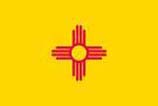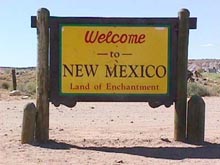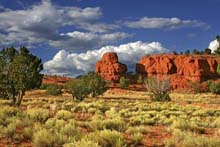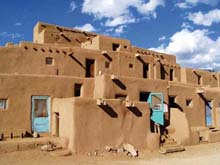About New Mexico
New Mexico is a southwestern state in the United States. Over its relatively long history it has also been occupied by Native American populations and has been part of the Spanish viceroyalty of New Spain, a province of Mexico and a U.S. territory. Among U.S. states, New Mexico has simultaneously the highest percentage of Hispanic Americans (some recent immigrants and others descendants of Spanish colonists) and the second-highest percentage of Native Americans (mostly Navajo and Pueblo peoples). As a result, the demographics and culture of the state are unique for their strong Spanish, Mexican, and U.S. Amerindian cultural influences.
With a Native American population of 134,000 in 1990, New Mexico still ranks as an important center of American Indian culture. Both the Navajo and Apache share Athabaskan origin. The Apache and some Ute live on federal reservations within the state. With 16 million acres, mostly in neighboring Arizona, the reservation of the Navajo Nation ranks as the largest in the United States. The prehistorically agricultural Pueblo Indians live in pueblos scattered throughout the state, many older than any European settlement.
Private service economy in urban New Mexico, especially in Albuquerque, has boomed in recent decades. Since the end of World War II, the city has gained an ever-growing number of retirees, especially among armed forces veterans and government workers. It is also increasingly gaining notice as a health conscious community, and contains many hospitals and a high per capita number of massage and alternative therapists. The warm, semiarid climate has contributed to the exploding population of Albuquerque, attracting new industries to New Mexico.
Cattle and dairy products top the list of major animal products of New Mexico. Cattle, sheep, and other livestock graze most of the arable land of the state throughout the year. New Mexicans derive much of their income from mineral extraction. Even before European exploration, Native Americans mined turquoise for making jewelry. After the Spanish introduced refined silver alloys they were incorporated into the Indian jewelry designs. New Mexico produces uranium ore, manganese ore, potash, salt, perlite, copper ore, beryllium, and tin concentrates.
Federal government spending is a major driver of the New Mexico economy. The federal government spends 2 dollars on New Mexico for every dollar of tax revenue collected from the state. This rate of return is higher than any other state in the Union. [5]. The federal government also a major employer in New Mexico providing more than a quarter of the state’s jobs. Many of the federal jobs relate to the military; the state hosts three air force bases (Kirtland Air Force Base, Holloman Air Force Base, and Cannon Air Force Base); a testing range (White Sands Missile Range); an army proving ground and maneuver range (Fort Bliss Military Reservation – McGregor Range); national observatories; and the technology labs of Los Alamos National Laboratory (LANL) and Sandia National Laboratories (SNL). SNL conducts electronic and industrial research next to Kirtland AFB, on the southeast side of Albuquerque.
New Mexico does not have a sales tax. Instead, it has a 5% gross receipts tax. In almost every case, the business passes along the tax to the consumer, so that the gross receipts tax resembles a sales tax. The combined gross receipts tax rate varies throughout the state from 5.125% to 7.8125%. The total rate is a combination of all rates imposed by the state, counties and municipalities. Started in 2005, New Mexicans no longer pay taxes on most food purchases; however, there are exceptions to this program. Also beginning Jan. 2005, the state eliminated the tax on certain medical services.
The climate of New Mexico is best summed up as sunny and dry. The main factor in the climate of the state is elevation. Summers in New Mexico are hot below 5000 feet in elevation with daytime highs frequently exceeding 100 °F. At the highest elevations, the upper 70’s °F is the summertime normal high temperature. The summertime peak is often reached earlier than in the rest of the United States and July and August often bring monsoon moisture to the state as moisture from the Gulf of Mexico comes into the state. Summer nights are comfortable as the temperature drops rapidly as the sun sets. The winters bring cooler temperatures than might be expected for a state at its latitude with daytime highs in the south part of the state only reaching around 55 °F in lower elevations in the south, while many higher elevations in the north barely average above freezing. Nights throughout the state tend to be below freezing in the winter. As a general rule, precipitation in New Mexico increases with elevation with the southern desert and the San Juan Valley receiving less than 10 inches per year, while the highest areas of the state receive more than 20 inches per year.
$state_id = ‘NM’ ;
global $state_id ;
[/insert_php]
[insert_php]
$state_id = ‘NM’ ;
[/insert_php]







